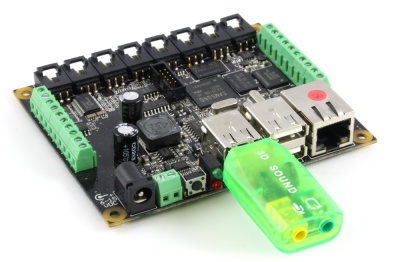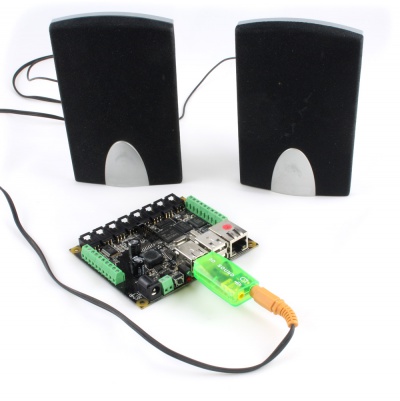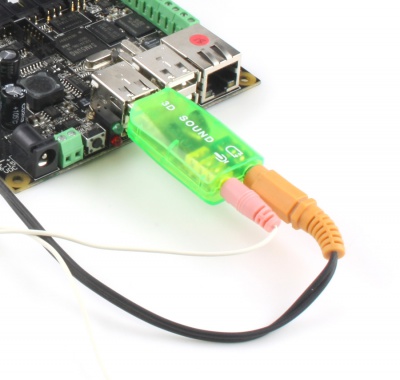The USB to Audio Adapter provides stereo sound capability to the PhidgetSBC. The device plugs into any of the SBC's USB ports and does not require any external power.
The SBC will automatically recognize the Audio Adapter when it is plugged in and will create a port for it.
The software driver is included in the PhidgetSBC.
Note: Color of plastic may differ from image.

|
The 3401 does not support volume adjustment. The audio adapter has two settings: mute or full volume. |

| |
| Go to this device's product page |
The 3401 USB to Audio adapter provides sound capabilities to the PhidgetSBC. The audio adapter offers two integrated channels - one for speakers or headphones, and one for a microphone. The Audio Adapter plugs into any of the PhidgetSBC USB ports. The USB to Audio Adapter is not a Phidget device and is not controlled using Phidgets APIs.
Using this product requires a working knowledge of Linux.

1. Log onto the SBC via SSH.
2. Plug the Audio Adapter into an open USB port on the SBC. The SBC should automatically recognize the converter.
Type dmesg | tail –n 5 on the SBC to view the last 5 lines of the kernel’s message buffer. You should see something similar to the lines below (this is output from a PhidgetSBC2):
usb 1-1.1: New USB device strings: Mfr=0, Product=1, SerialNumber=0
usb 1-1.1: Product: USB Headphone Set
input: USB Headphone Set as /devices/platform/s3c2410-ohci/usb1/1-1/1-1.1/1-1.1:1.3/
input/input0
usbcore: registered new interface driver snd-usb-audio
This tells you that the USB to Audio adapter was properly recognized.
1. Plug a set of headphones, or computer speakers into the green jack on the back of the audio device.

2. Included with the Phidget SBC is an mpeg audio playback program mpg123. To play an mp3 file, simple type:
mpg123 –g 100 filename.mp3
This file can be located either in your home director, or on a USB storage device. The -g 100 option tells mpg123 to turn the gain on the audio device to 100%.
3. The program can also be used to play streaming audio. If you SBC is connected to the internet through your home network, you can type a command like:
mpg123 -g 100 -@ http://www.di.fm/mp3/club.pls.
The -@ option tells mpg123 that the file is actually a playlist, not a sound file.
4. Your SBC should start playing music from the radio stream.

1. Plug a set of headphones, or computer speakers into the green jack on the back of the audio adapter.
2. Plug a microphone into the yellow jack on the back of the audio adapter.
3. You can test the input of the audio adapter by typing (1070 only):
cat /dev/audio > /dev/audio
The /dev/audio device can be used for both input, as well as playback. This command reads the input, and sends it right back to the output.
4. Speak into the microphone, you should be able to hear your voice on your headphones or speakers.
| Adapter | |
|---|---|
| I/O Communication Protocol | USB 2.0 |
| Physical Properties | |
| Connector Type | USB Type-A (Male) |
| Headphone Jack Size | 3.5 mm |
| Microphone Jack Size | 3.5 mm |
| Customs Information | |
| Canadian HS Export Code | 8473.30.00 |
| American HTS Import Code | 8473.30.11.80 |
| Country of Origin | CN (China) |